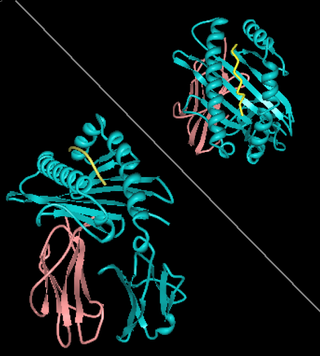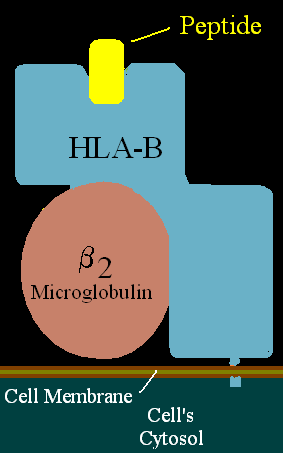HLA-DR2 (DR2) of the HLA-DR serotype system, is a broad antigen serotype that is now preferentially covered by HLA-DR15 and HLA-DR16 serotype group. This serotype primarily recognizes gene products of the HLA-DRB1*15 and HLA-DRB1*16 allele groups.
HLA-DR2 (DR2) of the HLA-DR serotype system, is a broad antigen serotype that is now preferentially covered by HLA-DR15 and HLA-DR16 serotype group. This serotype primarily recognizes gene products of the HLA-DRB1*15 and HLA-DRB1*16 allele groups.
| DRB1* | DR15 | DR2 | DR16 | Sample |
| allele | % | % | % | size (N) |
| 15:01 | 76 | 23 | 6428 | |
| 15:02 | 77 | 16 | 676 | |
| 15:03 | 81 | 13 | 286 | |
| 15:04 | >50 | 1 | ||
| 15:05 | >25 | 2 | ||
| 15:07 | >50 | 1 | ||
| . | ||||
| DR16 | DR2 | DR15 | N | |
| 16:01 | 41 | 29 | 19 | 703 |
| 16:02 | 47 | 30 | 16 | 239 |
| 16:04 | >50 | 1 | ||
DR2 serotypes are associated with Goodpasture syndrome, systemic lupus erythematosus, multiple sclerosis, [2] and narcolepsy, tuberculoid leprosy [3] (multi-drug-resistant tuberculosis or leprosy), [4] ulcerative colitis(Japanese), [5] primary biliary cirrhosis and autoimmune hepatitis. [6] DR2 is also found in all patients that test positive for anti-anti-Asn-RNA-synthetase and chronic interstitial lung disease. [7]
DR2 is linked to the HLA-DR51.

The human leukocyte antigen (HLA) system or complex is a complex of genes on chromosome 6 in humans which encode cell-surface proteins responsible for regulation of the immune system. The HLA system is also known as the human version of the major histocompatibility complex (MHC) found in many animals.

Autoimmune hepatitis, formerly known as lupoid hepatitis, plasma cell hepatitis, or autoimmune chronic active hepatitis, is a chronic, autoimmune disease of the liver that occurs when the body's immune system attacks liver cells, causing the liver to be inflamed. Common initial symptoms may include fatigue, nausea, muscle aches, or weight loss or signs of acute liver inflammation including fever, jaundice, and right upper quadrant abdominal pain. Individuals with autoimmune hepatitis often have no initial symptoms and the disease may be detected by abnormal liver function tests and increased protein levels during routine bloodwork or the observation of an abnormal-looking liver during abdominal surgery.
HLA-DQ6 (DQ6) is a human leukocyte antigen serotype within HLA-DQ (DQ) serotype group. The serotype is determined by the antibody recognition of β6 subset of DQ β-chains. The β-chain of DQ isoforms are encoded by HLA-DQB1 locus and DQ6 are encoded by the HLA-DQB1*06 allele group. This group currently contains many common alleles, DQB1*0602 is the most common. HLA-DQ6 and DQB1*06 are almost synonymous in meaning. DQ6 β-chains combine with α-chains, encoded by genetically linked HLA-DQA1 alleles, to form the cis-haplotype isoforms. For DQ6, however, cis-isoform pairing only occurs with DQ1 α-chains. There are many haplotypes of DQ6.
HLA-DQ9 (DQ9) is a human leukocyte antigen serotype within the HLA-DQ (DQ) serotype group. DQ9 is a split antigen of the DQ3 broad antigen. DQ9 is determined by the antibody recognition of β9 and this generally detects the gene product of DQB1*0303.
HLA-DQ1 is a serotype that covers a broad range of HLA-DQ haplotypes. Historically it was identified as a DR-like alpha chain called DC1; later, it was among 3 types DQw1, DQw2 and DQw3. Of these three serotyping specificities only DQw1 recognized DQ alpha chain. The serotype is positive in individuals who bear the DQA1*01 alleles. The most frequently found within this group are: DQA1*0101, *0102, *0103, and *0104. In the illustration on the right, DQ1 serotyping antibodies recognizes the DQ α (magenta), where antibodies to DQA1* gene products bind variable regions close to the peptide binding pocket.
HLA-DR53 is an HLA-DR serotype that recognizes gene products of HLA-DRB4 locus. There are 13 alleles at this locus that encode 7 proteins.
HLA-DR52 is an HLA-DR serotype that recognizes gene products of HLA-DRB3 locus. Three allele groups can produce 35 isoforms.
HLA-DR51 is a HLA-DR serotype that recognizes the antigens encoded by the minor DR locus HLA-DRB5.
HLA-DR17 (DR17) is an HLA-DR serotype that recognizes the DRB1*0301 and *0304 gene products. DR17 is found at high frequency in Western Europe. DR17 is part of the broader antigen group HLA-DR3 and is very similar to the group HLA-DR18.
HLA-DR16(DR16) is a HLA-DR serotype that recognizes the DRB1*1601, *1602 and *1604 gene products. DR16 is found in the Mediterranean at modest frequencies. DR16 is part of the older HLA-DR2 serotype group which also contains the similar HLA-DR15 antigens.
HLA-DR15 (DR15) is a HLA-DR serotype that recognizes the DRB1*1501 to *1505 and *1507 gene products. DR15 is found at high levels from Ireland to Central Asia. DR15 is part of the older HLA-DR2 serotype group which also contains the similar HLA-DR16 antigens.
HLA-DR11 (DR11) is a HLA-DR serotype that recognizes the DRB1*1101 to *1110. DR11 serotype is a split antigen of the older HLA-DR5 serotype group which also contains the similar HLA-DR12 antigens.
HLA-DR5 (DR5) is a broad-antigen serotype that is further split into HLA-DR11 and HLA-DR12 antigen serotypes.
HLA-DR3 is composed of the HLA-DR17 and HLA-DR18 split 'antigens' serotypes. DR3 is a component gene-allele of the AH8.1 haplotype in Northern and Western Europeans. Genes between B8 and DR3 on this haplotype are frequently associated with autoimmune disease. Type 1 diabetes mellitus is associated with HLA-DR3 or HLA-DR4. Nearly half the US population has either DR3 or DR4, yet only a small percentage of these individuals will develop type 1 diabetes.
HLA-DR4 (DR4) is an HLA-DR serotype that recognizes the DRB1*04 gene products. The DR4 serogroup is large and has a number of moderate frequency alleles spread over large regions of the world.

HLA-DR1 (DR1) is a HLA-DR serotype that recognizes the DRB1*01 gene products. It has been observed to be common among centenarians.

HLA-A1 (A1) is a human leukocyte antigen serotype within HLA-A "A" serotype group. The serotype is determined by the antibody recognition of α1 subset of HLA-A α-chains. For A1, the alpha "A" chain are encoded by the HLA-A*01 allele group and the β-chain are encoded by B2M locus. This group currently is dominated by A*01:01. A1 and A*01 are almost synonymous in meaning. A1 is more common in Europe than elsewhere, it is part of a long haplotype that appears to have been frequent in the ancient peoples of Northwestern Europe. A1 is a frequent component of the AH8.1 haplotype. A1 serotype positivity is roughly linked to a large number of inflammatory diseases and conditions believed to have immune system involvement. Because of its linkage within the AH8.1 haplotype many studies showed association with A1 or A1,B8 only later to show the association drift toward the class II region gene alleles, DR3 and DQ2.5. While it is not clear what role A1 has in infectious disease, some linkage with infection rates in HIV remain associated within the A1 region of the haplotype.

HLA-B52 (B52) is an HLA-B serotype. The serotype identifies the more common HLA-B*52 gene products.
HLA A1-B8-DR3-DQ2 haplotype is a multigene haplotype that covers a majority of the human major histocompatibility complex on chromosome 6. A multigene haplotype is set of inherited alleles covering several genes, or gene-alleles; common multigene haplotypes are generally the result of descent by common ancestry. Chromosomal recombination fragments multigene haplotypes as the distance to that ancestor increases in number of generations.
HLA A1-B8 is a multigene haplotype that covers the MHC Class I region of the human major histocompatibility complex on chromosome 6. A multigene haplotype is set of inherited alleles covering several genes, or gene-alleles; common multigene haplotypes are generally the result of identity by descent from a common ancestor. Chromosomal recombination fragments multigene haplotypes as the distance to that ancestor increases in number of generations.